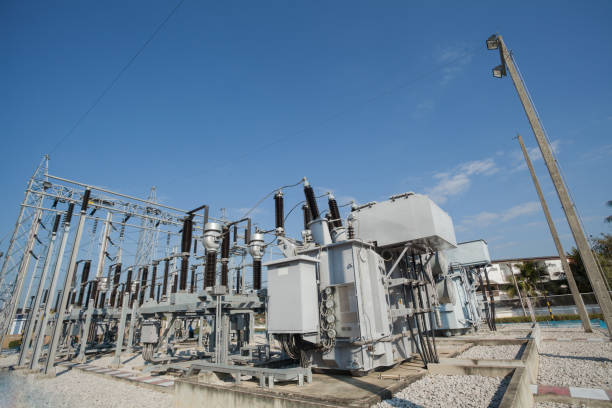Our Infrastructure’s Engine: An All-Inclusive Guide to Medium Voltage Transformer
The medium voltage transformer is an essential part of the electrical infrastructure because it makes it possible to transform and distribute electricity effectively for a variety of uses. These transformers are essential to maintaining a steady and dependable supply of electricity, whether they are powering industrial buildings or assisting with renewable energy initiatives like solar farms. We dig further into the realm of medium voltage transformers in this article, covering their kinds, uses, efficiency factors, and maintenance procedures.
Unveiling the Magic: How Medium Voltage Transformers Work
This voltage transformer is essentially a static electrical device that transfers electrical energy across circuits that use alternating current (AC) at different voltage levels. They function on the same electromagnetic induction mechanism as single-phase transformers. The transformer is composed of two electrical windings, a primary winding, a secondary winding, and a laminated steel core.
The voltage levels that medium voltage transformer and lower voltage transformers manage are the primary differences between them. Depending on the location, voltages between 1,000 and 69,00 volts are commonly referred to as medium voltage. The transformer’s voltage output is determined by isolating the number of tries in the key curving by the quantity of tries in the subordinate curving. Depending on the application, medium voltage transformers can be step-up or step-down, increasing or decreasing voltage.

Where to Find Medium Voltage Transformers for a World of Uses
The workhorses of electricity distribution, these transformers are essential in several industries:
Industrial Applications : These transformers supply electricity to motors, lighting systems, and machines inside industrial buildings. Large motors used in building projects, manufacturing operations, and other industrial equipment depend on them for power.
Commercial Applications : To effectively distribute electricity throughout the building, medium voltage transformers are frequently used in large commercial buildings, shopping centers and data centres.
Integration of Renewable Energy: As renewable energy sources such as storm and lunar farms proliferate, medium voltage transformers are essential to their integration into the current electrical system. They raise the voltage produced by windmills or solar panels to a level appropriate for transmission across great distances .
How Medium Voltage Transformers Optimize Power Distribution?
These transformers are essential for maximizing power distribution because they effectively reduce high-voltage grid electricity to levels that are safe for human use. These transformers make it possible for safe and dependable power to be transmitted across a range of applications by lowering voltage levels to the medium voltage range, which is normally between 2.4 kV and 72.5 kV. Because lower voltages lead to less resistive losses along power lines, this voltage decrease minimizes energy losses during transmission. Furthermore, medium voltage transformers make it easier to distribute power over long distances, supplying substations with electricity to users in the commercial, industrial, and residential sectors.
These transformers optimize system performance and maximize efficiency by ensuring that electrical energy is delivered at the proper voltage levels through impedance matching and voltage control. Additionally, medium voltage transformers isolate various electrical network components, improving safety and shielding equipment from transient events and voltage surges. Overall, medium voltage transformer is essential for optimizing power distribution systems for effective and sustainable operation because they improve voltage compatibility, lower losses, and guarantee system stability.
A Variety to Meet All Needs: Examining Various Medium Voltage Transformer
There are several designs in the category of medium voltage transformers that are appropriate for particular settings and uses:
Distribution Transformers:
The most prevalent kind of medium voltage transformers are distribution transformers. They scale down the voltage for distribution to homes, companies, and industrial buildings; they are usually found on utility poles or underground vaults. Distribution transformers fall into one of the following categories:
- Pad-Mounted Transformers: Usually situated on concrete platforms above ground, these transformers are encased in weatherproof enclosures. Because they are simple to maintain and utilize, they are frequently utilized in suburban and urban settings.
- Underground Transformers: This type of transformer offers a more visually beautiful option; however, access and maintenance need specialized equipment due to its subterranean location in vaults.
Transformers of the dry type:
These transformers use air, not oil, as the cooling medium. They are recommended in areas where environmental rules prohibit the use of oil-based transformers or where fire safety is an issue. On the other hand, dry-type transformers are usually more costly and bulkier than their oil-filled counterparts.
Transformers made of cast resin:
These transformers replace oil-filled transformers with an ecologically benign and fire-resistant alternative by using cast resin as insulation. Because of their advantages for the environment and safety, they are growing in popularity.
Autotransformers:
Although they are less frequently utilized in medium voltage applications, autotransformers have their uses. An autotransformer is a more compact and maybe more economical option for some applications since it transforms voltage using a single coil with taps.
Tips for Maintenance and Troubleshooting
For these transformers to operate dependably and to increase their longevity, proper maintenance is essential. Proactive maintenance can help avoid problems before they arise and reduce unscheduled downtime. Here are some crucial guidelines for upkeep and troubleshooting:
Visually inspect components on a regular basis for indications of corrosion, overheating, or leaks. Pay special attention to insulation, bushings, and connections. Periodic oil sampling and analysis can reveal information about the state of oil-immersed transformers by identifying possible problems like contamination or moisture infiltration. Using external probes or inbuilt sensors, keep an eye on transformer temperatures and take appropriate action if temperatures rise over advised levels. When anything goes wrong or operates strangely, utilize diagnostic methods like dissolved gas analysis (DGA) to find the source and start fixing it right away.
Conclusion:
Visit Shinenergy , your go-to resource for cutting-edge energy solutions and knowledgeable advice, for more information about medium voltage transformers and related subjects. Use a medium voltage transformer to your advantage and maintain your empowerment for a more sustainable and better future.

